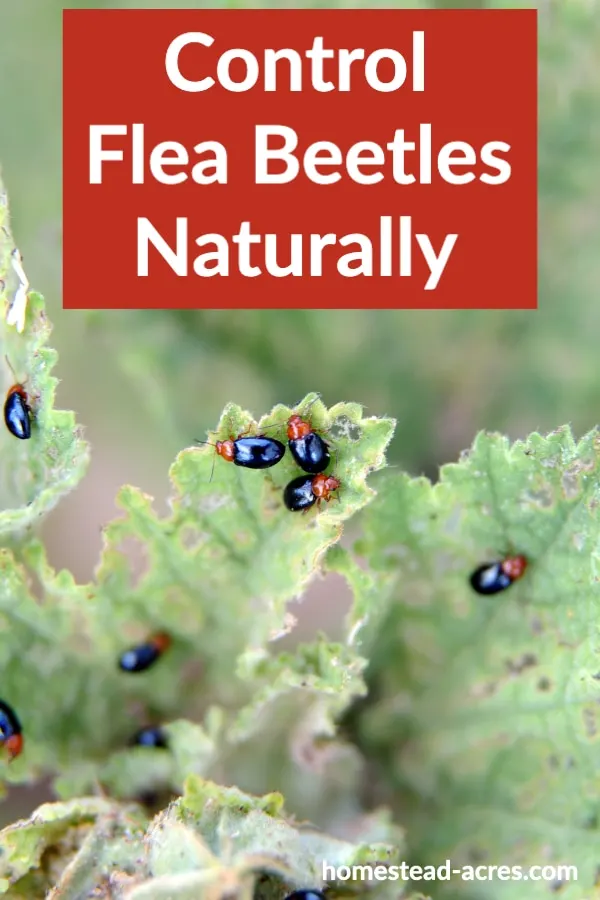This post may contain affiliate links, my full disclosure can be read here. As an Amazon Associate I earn from qualifying purchases.
Are you wondering how to get rid of flea beetles in your garden?
Flea beetles are a tiny insect that is a big pest for home gardeners and farmers. But there are many ways you can control them in your vegetable garden including row covers, diatomaceous earth, and neem oil.
Let’s explore this pest more so you can learn more about its lifecycle and how to protect your plants from damage to have a great garden.
Flea beetles (Chrysomelidae) are a common pest in most gardens that left untreated can cause a lot of damage.
They will eat many plants but their favorite vegetables are cabbage, kale, broccoli, collards, turnips, radishes, tomatoes, peppers, eggplant, potatoes, beans, and corn.

Identification

Flea beetles are tiny garden insects that grow to be 1/16 to 1/8th inch (1.58 to 3.17 mm) long. The exception to this is the spinach flea beetle that grows to 1/4 inches (6.35 mm) long.
They come in many colors, not just the typical black that you think of. Other types of flea beetles can be brown, bluish, bronze, or metallic grey.
Most are solid colored although a few species have stripes.
You’ll notice them as little specs on your plants, but as you approach them they jump away quickly.
This is likely how the flea beetles get their name, with their dark color and amazing jumping ability they remind you of the common flea.
The larva is a tiny, cream-colored worms 1/8 to 1/3 of an inch (3.17 to 8.46 mm) long. They live underground feeding on the roots of young plants.
The most common flea beetles in North America are:
- Crucifer flea beetle (Phyllotreta cruciferae)
- Spinach flea beetle (Disonycha xanthomelas)
- Striped flea beetle (P. Striolata)
- Potato flea beetle (Epitrixcucumeris)
- Western black flea beetle (P. Pusilla)
Lifecycle
Flea beetles overwinter in garden debris, brush, and wooded areas. They start to emerge in the early spring when the weather reaches 50F (10 C) to feed on young plants.
They lay tiny white eggs in the soil around the base of plants.
The eggs hatch in about 7 days, then the tiny white larva will feed on plant roots for 2 to 3 weeks. The larva look like tiny white grubs in the soil. Their bodies are an off white color with a brown head.
The larva stage lasts 25 to 34 days until they grow to full size 0.11 to 0.15 inches (3 to 4 mm).
When the larva has finished growing they then pupate for 7 to 9 days before emerging as an adult to start the pest cycle over again.
Damage

The damage to plants is often miss identified as cabbage worms or cabbage looper. But you’ll easily be able to recognize the damage caused by flea beetles if you know what to look for.
The leaves will have a shot-hole appearance looking like they’ve been blasted with many round holes. But left untreated it doesn’t take long for flea beetles to completely defoliate a young plant.
The damage is most harmful to young seedlings that don’t have enough leaves or root systems to help them recover from the feeding.
Flea beetles don’t normally cause permanent damage to older plants that are well established. Their leaves and root systems are larger and the plant has the ability to regrow quickly.
The biggest danger caused by these beetles is the bacterial diseases they spread while feeding. Wilt and blight are the most common, and a good reason to start controlling this pest right away.
How To Get Rid Of Flea Beetles
There are many natural ways to get rid of flea beetles in your garden.
1. Diatomaceous Earth (DE)
Food grade diatomaceous earth works really well to control flea beetles.
Simply sprinkle a little over your plants and on the soil around them. This organic powder can cut through their shell and kill the beetles when they are active on your plants.
2. Neem Oil
Neem oil is another organic product that you can use to protect your plants.
Neem oil interferes with the natural hormones in insects causing a disruption in their egg production. It can also kill many pests when sprayed directly on them as it coats their body making it hard for insects to breathe.
As with any oils natural or otherwise you should test it on a small area of your plant before spraying the whole thing down.
3. Insecticidal Soaps
Insecticidal soap is a traditional way of managing pests in the garden. Sprayed directly on insects it can kill them by causing suffocation.
Most insects also dislike the taste of soap on the plant leaves and may go elsewhere to feed.
You can get insecticidal soap here.
4. Yellow Sticky Traps
Yellow sticky traps are a great non toxic way of controlling flea beetles in your garden too.
Placing these traps around your plants will catch flea beetles that land on them while jumping from plant to plant.
You can get yellow sticky traps here.
How To Prevent Flea Beetle Damage
Flea beetles emerge early in the spring and with little growing at that time your young seedlings are a prime target for them.
1. Delay Planting
One simple way to protect your plants is to delay planting by a few weeks. Once there are more wild plants naturally growing outside your garden vegetables will be less of a temptation.
2. Row Covers
Floating row covers can also be used to protect your plants from flea beetles. These need to be put over your plants as soon as you transplant them into the garden.
Keep the edges well sealed so the pests can’t sneak in is also very important. Row covers only work for pest prevention if you keep them raised off the tops of the plants and the edges sealed down tightly.
Beneficial Insects
There are many natural predators of flea beetles including braconid wasps and tachinid flies.
Attract Beneficial insects by planting plants that attract them throughout your garden.
Plants like thyme, catnip, mint, dill, chamomile, clover, anise, and marigolds are excellent for attracting parasitic wasps and many others that feed on pests.
The most important thing in preventing flea beetle damage is to start early in the season.
As soon as you transplant your seedlings into your garden start using row covers or natural pesticides to keep the beetles from damaging your vegetables.
Common Flea Beetle Questions & Answers
Do Flea Beetles Bite?
No, although they look similar to the fleas you find on dogs and cats they are completely different creatures. Flea beetles feed on plants not animals or people.
Does Mulching Your Garden Attract Flea Beetles?
No not at all. Flea beetles feed on plants, but their larva lives in the soil not in the mulch.
Mulching your garden can actually help prevent a flea beetle problem because mulch give many places for their natural predators to live in.
Where Do Flea Beetles Come From?
Flea beetles seem to come out of know where, but that’s because they over winter in garden debris and come out in the spring when temperatures warm up.
Using good control methods during the growing season will lower the number that can overwinter in your garden.
How To Get Rid Of Flea Beetles
Equipment
Materials
- Diatomaceous earth
- Neem oil optional
- Insecticidal soap optional
- Yellow sticky traps optional
- Bug netting optional
Instructions
- Diatomaceous earth is one of the easiest ways to get rid of flea beetles on your plants. Simply sprinkle a light dusting of food-grade DE over your plants and on the soil around them. This non-toxic powder will kill the beetles and deter new ones from coming onto your plants.
- Spraying plant leaves with neem oil can get rid of flea beetles and discourage them from feeding on the leaves. It also interferes with insects’ ability to reproduce slowing down the lifecycles.
- Insecticidal soaps work well to kill flea beetles on your plants. However, it has to make direct contact to work. It does leave a taste on the leaves that most garden pests dislike.
- Yellow sticky traps are another non-toxic way to control flea beetles. Place a few traps in between your plants to catch them when they jump from plant to plant.
- How To Prevent Flea Beetles
- Flea beetles can be a worse pest in the early spring when they have little to feed on naturally. Try to delay your plantings by a few weeks. This gives them wild plants to feed on and your vegetables may be less of a temptation.
- As soon as you transplant your vegetables into the garden cover them with a bug netting. Suspend it over the plants with hoops and secure the edges down tightly.
- Braconid wasps and machined flies are natural predators of flea beetles. Help encourage them to visit your garden by planting herbs and flowers that they like such as thyme, mint, catnip, dill, chamomile, anise, clover, and marigolds.
Connect With Homestead Acres!
Be sure to follow me on social media, so you never miss a post!
Facebook | Twitter | Pinterest | Twitter
Visit my Amazon store to find all my favorite gardening, homesteading tools, and gadgets plus all of my printed garden books and journals!

Kim Mills is a homeschooling mom of 6 and lives on an urban homestead in Ontario, Canada. Blogging at Homestead Acres she enjoys sharing tips to help you save money, grow and preserve your own food.



Annette
Sunday 26th of April 2020
when I saw those red and black beetles I knew what they were! Now if I need to I can get rid of them.
Kim
Friday 1st of May 2020
Yes, they can be a real pest!